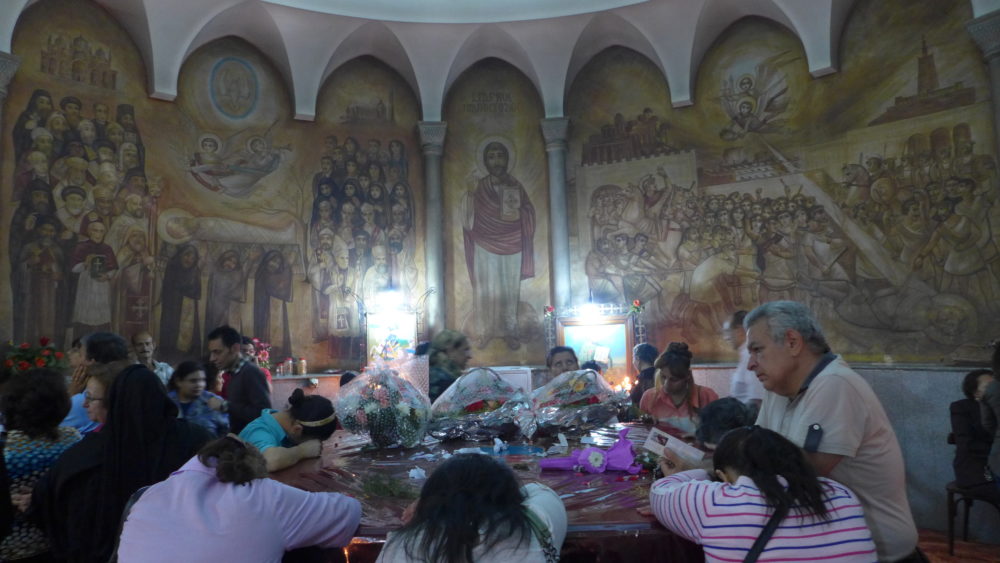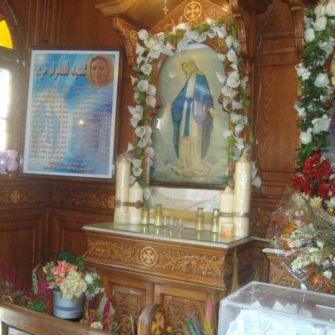
Towards the end of The Political Lives of Saints, Angie Heo says an imperative notion in a very quiet way: “The repression of holiness is, in fact, what animates the social imaginary of the wonderworking underground” (213). The entirety of what precedes proves the political fact of this sotto voce assertion. Once you read it, you pause: right. That’s exactly right.
Freckling this volume are instances like these, poignant encapsulations of the theoretical frontier where Heo draws her readers. “Collective images of the self are necessary for communal self-transformation,” we read in one early chapter (38). “To the extent that Christians and Muslims have mixed sensibilities of what a saint or wonderworker does and looks like, they thus compose a shared religious public” (180). The data of this volume doesn’t ascend to a lengthy abstract disquisition about the anthropology of mediation. Instead, The Political Lives of Saints is an in-depth drop into the political work of boundary maintenance between Christianity and Islam in Egypt. “The sectarian divide is owed, not to essential, irreconcilable differences between Christianity and Islam but to common points of overlap between Christian and Muslim practices of visual mediation and saintly manifestation that enabled public disorder” (204). Holy power transacted in the common currency of saints is the integrant of communal difference. Through this book, Heo never wavers from her practical effort to convey the ecumenism of saints in the diversity of community.

I have run a bit too far ahead, perhaps. Angie Heo exposes here a particular situation in which the mediation between two religious groups (Christian and Muslim) composes the state in which they mediate (Egypt). Heo looks at a variety of specific material things—a hand exuding oil, a saint’s relic, or a film depicting a saint’s death—but doesn’t linger on that object’s physical particularity as much as she focuses on the “embodied skills and media technologies” that connect communities to those things. How are we able to kiss or press our face into one particular artifact? How do we know the meaning of a priest’s hand as we embrace it? It isn’t a stock image of holiness Heo examines, but the way baraka, holy power, becomes ours. Baraka channels through air, oil, and fragrance; also, too, it travels through “tactile sympathy and televisual extension” (77). And its travel is round-trip, sent back by me as something else after the smear becomes spirit. The oil or the hand aren’t the point, but the process. The mediating witness is the power of holy power.
Even though I’m tumbling into intimacy, Heo’s gaze isn’t so easily distracted. She takes us to a critical political epoch—post-1952 Egypt—and examines it through the 6-10 percent of its population that comprises Arab Middle East’s largest “religious minority,” the Copts. The Copts, in Heo’s retelling, are the minority metonym that articulates the mass. Located in the ellipsis between the Christian West and Arab Islam, Copts claim Egyptian origins and Egyptian dominion. Many sectarian groups define their sociological, ideological, and spiritual experience in opposition to centralized power. The Copts, however, have become the prime articulation of state power, a self-understanding that Heo exposes as incorporated into their every ecclesial decision, from deciding which of their church buildings are axiomatically national sites of worship, to restricting public access to miraculous incidents. Heo wants “to deprivilege the sensationalizing din of persecution politics and Islamophobia that currently overdetermines the global portrait of Copts” through an examination of Coptic hagiography and martyrology (5). Coptic secularists might try to sequester the Copt sensorium to mere spiritual consequence, but to no avail: orthodox adherents refuse to hide their reverence for bishops or felt connection to relics. No secularism can shunt their enfolding in holiness.
But that secularism can and will, as the inaugurating quotation suggests, elaborate, even encourage, that holiness. Canonization has mimetic political effects, as Heo wagers in her careful final comment on the communal legibility of ISIS’s beheading videos. Although the majority of Heo’s examples emerge from specific churches and specific everyday encounters, her focus at the end on the popularity of violent martyrdom in contemporary geopolitics suggests the force of this accrual isn’t about quiet holiness but holiness crying out from the fissures of a dissatisfying secular. Heo seems to be saying that the more the miraculous, oil-exuding religious is routed away from the public, the more the public starves for real religious feeling.
By the time the reader arrives at this archive of martyrs’ bodies, she has traveled through much more quotidian and churchly familiar climes with Heo. She has visited the Church of the Virgin in Zaytun, the Church of the Virgin in Musturud, the Cathedral of St. Mark in Azbakiyya, and the Church of St. Bishoi the Great in Port Said. She has, with Heo, taken night classes at the Clerical College in the Archdiocese of Qalyubiyya in Shubra al-Khayma, visiting graves of martyrs, and attended feast-day celebrations for St. Simon the Tanner. She has witnessed discussions of miraculous appearances and dissected techniques described in tracts for disproving claims of laser usage at apparition sites. She has met deaconesses and demon exorcists, students and priests, filmmakers and garbage handlers, construction workers and shopkeepers. She has met, in one exquisitely rendered passage, a convert named Khalid. Heo’s ethnography is a model effort to think theoretically through the gorgeous diffusion of the human particular. Yet her gentle turn from this hand-crafted ethnographic mélange to the mass-mediated violence of ISIS suggests that the purpose of her interest in the diffusion is the case it makes for wonderwork as a human need. Heo incorporates the best political critique of religion without forgetting the very human subjects that comprise her ethnographic and theoretical capacity to think, see, feel, or know. This is a work with which students of religion will be thinking for some time, learning from it anew what it is to classify holiness in empires of religion.

